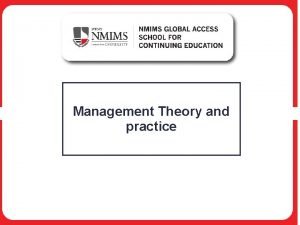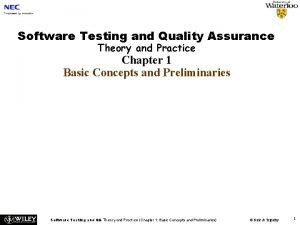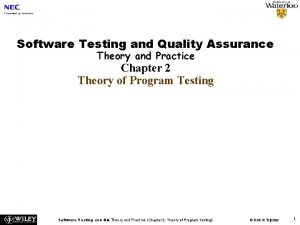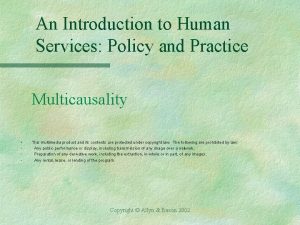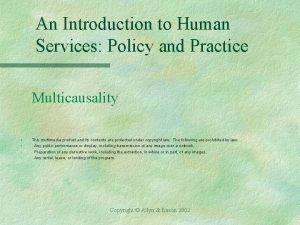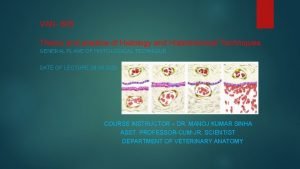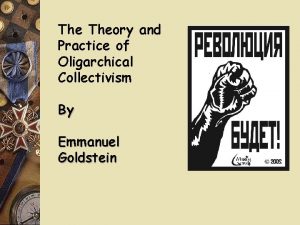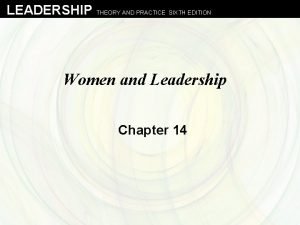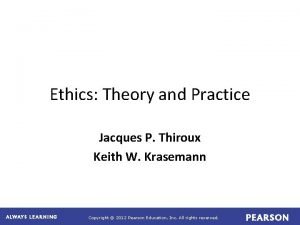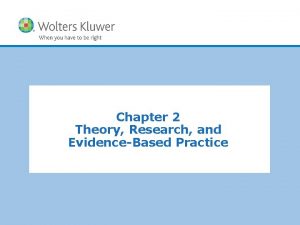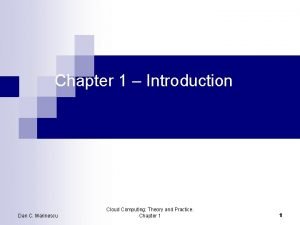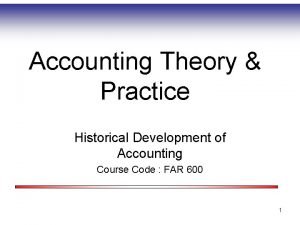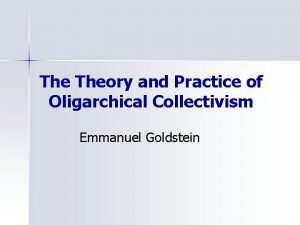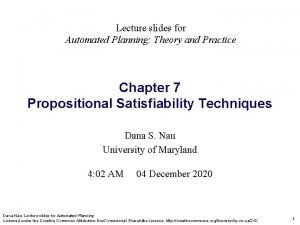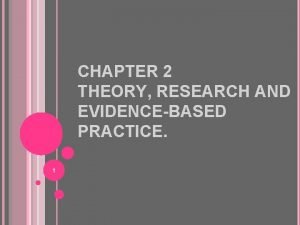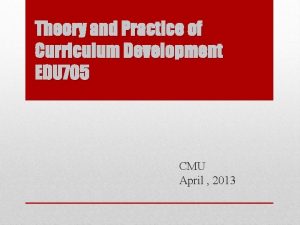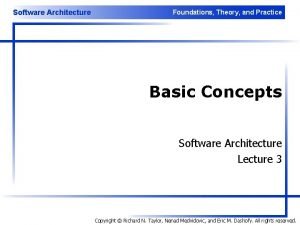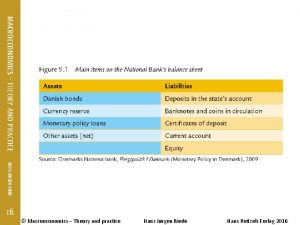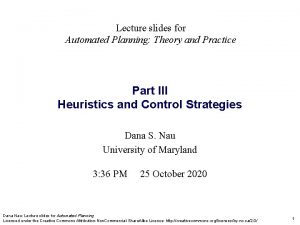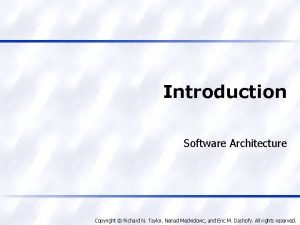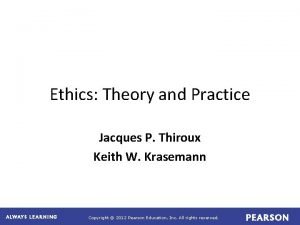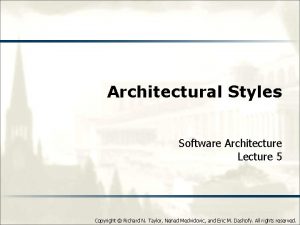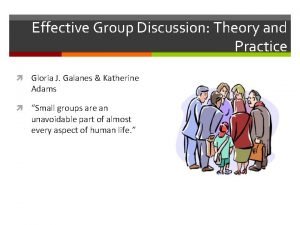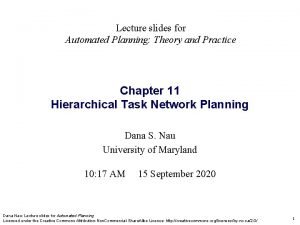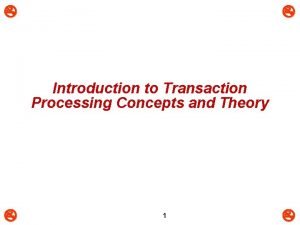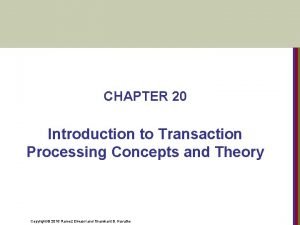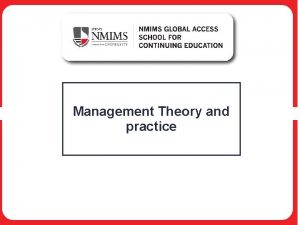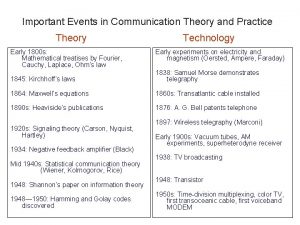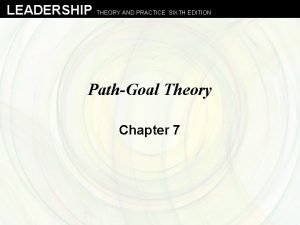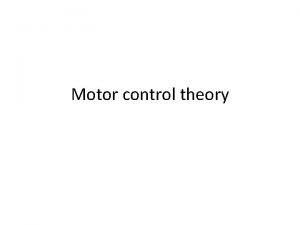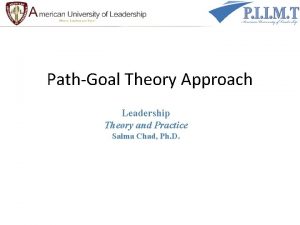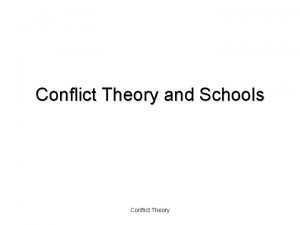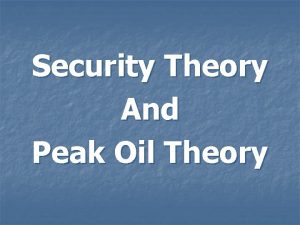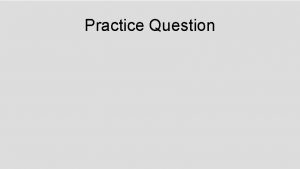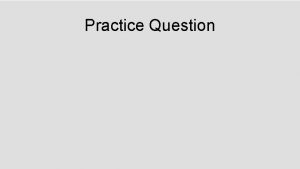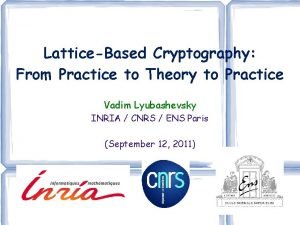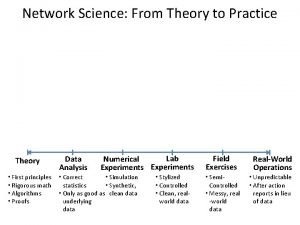Management Theory and practice Introduction Management is a














































- Slides: 46

Management Theory and practice

Introduction • Management is a universal phenomenon and is concerned with all the aspects of an organisation’s functioning. • The success of an organisation depends a great deal on the effectiveness of management. The main objective of management is to draw maximum output of minimum efforts and resources. Therefore, every organisation must ensure effective management. • Efficiency and effectiveness are the two important aspects of successful management. This is because management is a problemsolving process of effectively achieving the objectives by efficient use of resources. • In an organisation, management is operated through a number of functions called management functions. These functions are planning, organising, staffing, directing and controlling.

Chapter 1 Evolution of Management

History of Management • The history of management can be traced back to 5000 B. C. when the agriculture revolution was at the initial stage. • In Egypt, in 2900 B. C. , the pyramids were built in a highly organised and coordinated manner. • Management was also a part of the Roman Empire, which organised its general administration and controlled its political, military and judgmental issues by using effective communication.

History of Management Industrial Revolution (1760 to sometime between 1820 and 1840. ) Industrial revolution was a period of transition from manual production methods to new manufacturing processes in the late eighteenth century. During industrial revolution, management was based on two main propositions, which are: • Firstly, labour was perceived as a bunch of lethargic people who would work only when controlled and supervised. • Secondly, labour was the only factor that could bring reduction in costs. Therefore, all the efforts were made to reduce labour costs and increase production.

History of Management Industrial Revolution There were many characteristics of industrial revolution. Some of the important characteristics are: ü Specialisation ü Standardisation ü Synchronisation ü Maximisation ü Centralisation

History of Management Industrial Revolution - the important characteristics: • Specialisation: During industrial revolution, the principle of division of labour was followed wherein each worker was allotted a particular job with the purpose of achieving specialisation in that job. • Standardisation: During the industrial revolution, the main focus was laid on standardisation wherein identical products were produced in huge quantities. • Synchronisation: It refers to the blending of all different elements at one place. • Maximisation: Here, it refers to the maximisation of production. • Centralisation: Centralisation means that all controlling powers lie in the hands of top management.

History of Management Forces Behind Management Thoughts • Forces Affecting Management Thoughts • Political Forces • Social Forces • Economic Forces

History of Management Forces Behind Management Thoughts • Political forces: Political forces, such as government regulations, political institutions, and trade policies affect in the areas of environmental analysis, organisational design and structure, and employee rights. • Social forces: These forces can be in the form of social norms arising from the values and beliefs of people in a society. • Economic forces: These forces are responsible for the formation of base market economy and other concepts, such as private ownership of property, economic freedom, and competitive markets.

Approaches to Management Classical Approach These approaches are discussed as follows: • Scientific Management: The scientific management approach was developed by Frederick Winslow Taylor (1856 -1915), who was an American engineer. Thus, scientific management is also popular by the name of Taylorism. • Administrative Management: Henry Fayol (1841 -1925), a French mining engineer, promoted the concept of administrative management. He focussed on developing administrative principles that could be applicable to both general and higher managerial levels. • Bureaucratic Management: Bureaucratic management was promoted by Max Webber (1864 -1920), who was a German sociologist. According to Webber, bureaucratic management is the most appropriate administration.

14 principles by Henri Fayol 1. 2. 3. 4. 5. 6. 7. 8. 9. 10. 11. 12. 13. 14. Division of labour Authority and responsibility Discipline Line of authority Centralization Unity of direction – one plan of action Unity of command – one boss Order – right job Initiative – encourage innovation Equity Remuneration Stability of tenure General interest over individual interest Esprit de corps – union is strength – harmony and mutual understanding.

Approaches to Management Modern Approach According to this approach, employees do not necessarily work for money and they also like to receive affection and respect of co-workers, which further increases their productivity. • Quantitative approach: In this approach, quantitative tools are used for managerial decision making. • Operations research: It is an approach used for improving the effectiveness of management decisions. • Operations management: It is used to manage production in manufacturing organisations.

Approaches to Management Modern Approach • Management information system (MIS): This is a computerised management system used to provide information required by organisations for their effective management. • Systems approach: According to this approach, a system can be defined as a set of components that are interacting regularly or are interdependent, thus making a single unit. • Contingency approach: In this approach, an organisation determines problems by analysing its conditions and environment.

Major Contributors • • Charles Babbage Fredrick W. Taylor Henry Laurence Gantt Henri Fayol Robert Owen Max Webber George E. Mayo

Major Contributors Charles Babbage • Charles Babbage (1792 -1891) was a mathematician, philosopher, and a mechanical engineer. • In his view, human factor plays a significant role in the success of an organisation; therefore, employees should be associated with the management in a manner that benefits both. • He also developed the concept of profit sharing and participative decision making. • He advocated the use of quantitative methods and industrial engineering techniques to improve manufacturing.

Major Contributors Frederick W. Taylor Fredrick Winslow Taylor is known as the father of scientific management. Taylor was also known for his contributions in the following areas: • Use of descriptive cost accounting • Concept of mutual understanding between workers and management • Provision of bonus to workers for making suggestions for improvement in productivity • Invention of an analytical machine, also known as differential machine.

Major Contributors Henry Laurence Gantt • Henry Laurence Gantt was a management consultant. • Gantt has been known for developing ‘Task and Bonus Plan. According to the plan, bonus must be paid to those managers who teach their employees to finish tasks efficiently in the given time period. • His best contribution emerged in the form of Gantt charts, which are visualdiagrammatic tools used for creating production schedules. • The other variations of Gantt charts are Program Evaluation Review Technique (PERT) and Critical Path Method (CPM).

Major Contributors Henri Fayol is also considered as the father of modern management. He also laid down best practices for managers, which are as follows: • Managers must be able to complete work within a specified period of time • Managers must organise both human and non-human resources in order to carry out tasks effectively. • Managers must take commands while selecting and assessing workers. • Managers must coordinate with all the workers for sharing information problems. • Managers must ensure that all the activities are carried out as planned. and

Major Contributors Robert Owen • According to him, investing in human resource is far more intelligent than investing in other assets. He advocated that employees should be working because they are interested in it rather than being forced. • He also propounded that there should be a harmonious relationship between managers and employees in order to improve the efficacy of production. • His philosophy and ideas are considered as a forerunner to the development of behavioural approach of management.

Major Contributors Max Weber is famous for developing the bureaucratic management theory in which he emphasised on the requirement of a hierarchy in organisations. Weber perceived three types of administration, namely traditional, charismatic and bureaucratic. • In traditional organisations, managerial positions are handed down from one generation to the other irrespective of intelligence, knowledge, and experience. • In charismatic organisations, management functions are not delegated and all the employees are considered to be the loyal subjects of a leader. • In bureaucratic organisations, a person is given a managerial responsibility as per his/ her capability.

Major Contributors George E. Mayo • He is famous for his contribution in Hawthorne studies. • Mayo was involved in the project in 1929 and 1930, and interviewed the workers involved in the experiments. • The outcome of his findings in Hawthorne studies later gave way for the human relations movement. The movement focuses on the concept of job satisfaction, group norms, and leadership quality and their significance in the improvement of productivity.

Recent Developments in Management Just In Time and Lean Production • JIT is a philosophy of continuous improvement, wherein unused or waste resources are identified and removed. The technique of JIT was first used by an American organisation called Ford Motor Company during the 1920 s. However, the technique is known as Japanese Innovation because it was popularised by Toyota Motor Corporation of Japan in 1954. • Lean manufacturing is a management philosophy that is based on eliminating the activities that do not add any value to the end product and finding efficiencies. In lean manufacturing, the approach of ‘less is better’ is adopted to produce goods on demand only.

Recent Developments in Management Some other Important Developments in Management • 5 S • Six Sigma • Kaizen

Recent Developments in Management Some other Important Developments in Management 5 S: It is a waste eliminating technique used in organisations to improve production efficiency. This technique comprises Japanese words beginning with ‘S. ’ • Seiri (Sort): It refers to organising the work area in such a manner that all the unnecessary items are eliminated. • Seiton (Straighten): It refers to arranging all the required items in an accessible range for users and substitutes too. • Seiso (Shine): It refers to keeping machines, equipment, and tools clean. • Seiketsu (Standardise): It refers to standardising the practices so that they are similar across all the workstations that indulge in same type of job. • Shitsuke (Sustain): It refers to continuing the process of improvement.

Recent Developments in Management Some other Important Developments in Management Six Sigma: It is a technique that lays emphasis on measuring the quality to attain perfection. Six Sigma was developed at Motorola in 1986 for improving processes. . In the process of Six Sigma, 99. 99966% of the products manufactured are statistically expected to be free of defects (3. 4 defective parts/million). Kaizen: It is a Japanese word which means "improvement" or "change for the best. ” It can be described as a philosophy or practice that emphasises continuous improvement of processes in manufacturing, engineering, and business management.

Chapter 2 Nature of Management

Definition of Management • Management is a process of creating and maintaining an environment where individuals work together to achieve certain goals by using the available resources optimally. • It is an integral part of every organisation as it helps in planning and coordinating the activities of the organisation. • According to American Management Association, “Management is guiding human and physical resources into dynamic organizational units which attain their objectives to the satisfaction of those served and with a high degree of morale and sense of attainment on the part of those rendering service. ”

Nature and Purpose of Management • The following characteristics of management highlights its nature: – Management is goal oriented and purposive – Management is universal – Management is continuous – Management is a group activity – Management is intangible

Various levels of communication • Communication with your Peers: – Peers could be helpful through expertise if you share. – Consider if you could be any added push for their assistance and success. – This communication will assure you both have the information needed to improve yourselves and your teams.

Nature and Purpose of Management • The purpose of management has been highlighted in the following points: – Achievement of goals and objectives – Optimum utilisation of resources – Cost minimisation – Survival and growth – Development of a nation

Successful communication = successful business • • • Basis of planning Basis of decision making Creating coordination and cooperation Establishment of effective leadership Development of human relations Helpful in building image Helpful in achieving peace and effective control Leading to high morale and motivation Unseen infrastructure of an organization Helpful in delegation of authority.

Management as a science • Management is called science as it has its own principles that can be applied everywhere. According to the principle, if the same work is given to a person repeatedly, he/she gains expertise in that work whether it is the personal or professional life of the person. • It should be noted that management is not like natural or exact science but it is more like behavioural science. This is because in case of natural science, it is possible to study the effects of any of the factors affecting a phenomenon by keeping other factors constant.

Management as an art • According to management experts , management is a skill that comes from an individual’s personality and ability. Thus, it is said that managers are born, not made. • In addition, experts believing in management as an art propounded that managers need to rely on the social and political environment and use their own body of knowledge to determine a course of action.

1. Functions of Management Planning Organising Directing Staffing Controlling

Role of Management in Society • Management is not only a representative of managers and employees but also has to fulfil certain objectives of a society. The management’s role towards society is as follows: – Providing good quality products at fair prices to consumers. – Making timely payment of taxes to the government. – Conserving the biological environment and natural resources. – Dealing fairly with suppliers, dealers, competitors, and other third parties. – Preserving the ethical values of a society.

Organisations commonly follow three approaches to meet social responsibility • Considers a business as an economic purpose and social reposnsibility as an Social obligation approach obligation Social responsible approach Social responsive approach • Considers a business from both social and economic point of view • Works actively to deal with social needs and problems

Social Responsibility towards different Interest Groups • • • Responsibility towards shareholders Responsibility towards customers Responsibility towards employees Responsibility towards community and society Responsibility towards government Responsibility towards other stakeholders

Management and Administration • Administration and management are closely related. Both involve integrating resources and directing individuals towards the achievement of goals. • Some authors have treated administration and management as separate concepts. For instance, Oliver Sheldon explains “Administration as a function is concerned with the determination of the corporate policy, the coordination of finance, production, and distribution, the settlement of the compass (i. e. , structure) of the organization, under the ultimate control of the executive, while management is concerned with the execution of the policy, within the limits setup by administration and the employment of the organization for the particular objects before it. ” • Thus, according to Oliver Sheldon, administration is a thinking process, whereas management is a doing process.

Management and Administration • Administration is a part of management: According to Kimball, Richman, and Copen, administration is only an implementing agency, thus is a part of the management. • Administration is different from management: As per this view, administration is a higher level activity, while management is a lower level function. Administration involves making crucial policies, thus is superior to management as the later has an unimportant role in determining objectives and policies. • Administration and management are synonymous: Various authors, such as Newman, Koontz and O’donell, Henri Fayol, William Newman, Chester Barnard, George Terry, and Louis. A. Allen, do not differentiate between administration and management.

Distinction between Management and Administration Point of Administration Management Nature It is a thinking function. It is a doing function. Type of Work It determines major objectives and It implements objectives policies. and policies. It is a top-level function. It is a middle and lower Difference Levels of Authority level function. Important Planning and controlling are the Directing and organising Functions main functions involved in it. are the main functions involved in it.

Management as a profession • Prof. Dalton E. Mc. Farland has given five characteristics of a profession: 1. The existence of a body of specialised knowledge and techniques 2. A formalised method acquiring training and experience 3. Establishment of a representative organisation with professionalism as its goal 4. Ethical codes of conduct 5. Due regards for the priority of a service over the desire for monetary reward

Case Study • General Motors – American Multinational – Automobile manufacturers. • Various well known cars. • 1982, GM was suffering from heavy losses due to tense labour management relations. • As a result California Facility was closed down. • To recover from the fall out, GM established first joint venture with Japanese organization Toyota Motors in 1983. • New Venture was named as – NUMMI – New United Motor Manufacturing Inc.

Case Study • To increase productivity NUMMI adopted the time and motion studies techniques for improving work practices. – Time and Motion studies: Method for establishing employee productivity standards in which • A complex task is broken into small, simple steps • The sequence of movements taken by the employee in performing those steps is carefully observed to detect and eliminate redundant or wasteful motion • Precise time taken for each correct movement is measured. From these measurements production and delivery times and prices can be computed and incentive schemes can be devised. Generally appropriate only for repetitive tasks, time and motion studies were pioneered by the US industrial engineer Frederick Winslow Taylor (1856 -1915) and developed by the husband wife team of Frank Gilbreth (1868 -1924) and Dr. Lillian Gilbreth (1878 -1972)

The aim • Improve overall quality • Encourage worker’s participation in designing and controlling of their own work activities • Create a former system in organization to foster learning.

New Management Practices used at NUMMI • Kaizen to attain perfection and for efforts towards continuous improvement. • Just-In-Time for reducing overall costs • Focus on human resources • Employee empowerment to provide quick solutions to problems • Effective team culture and mutual trust to gain control and coordination.

Thank You
 Management theory and practice
Management theory and practice Myeplg website
Myeplg website Software testing and quality assurance: theory and practice
Software testing and quality assurance: theory and practice Social fitness training
Social fitness training Software testing and quality assurance: theory and practice
Software testing and quality assurance: theory and practice Theory of goodenough and gerhart
Theory of goodenough and gerhart Software testing and quality assurance theory and practice
Software testing and quality assurance theory and practice Quality assurance theory
Quality assurance theory Multicausality in human services
Multicausality in human services An introduction to human services policy and practice
An introduction to human services policy and practice Theory and practice of histotechnology
Theory and practice of histotechnology Oligarchical collectivism
Oligarchical collectivism Leadership theory and practice 6th edition
Leadership theory and practice 6th edition Jacques p thiroux
Jacques p thiroux Theory research and evidence based practice
Theory research and evidence based practice Dan c. marinescu
Dan c. marinescu Accounting theory and practice notes
Accounting theory and practice notes Coaching theory and practice
Coaching theory and practice The theory and practice of oligarchical collectivism
The theory and practice of oligarchical collectivism Automated planning theory and practice
Automated planning theory and practice Educational psychology chapter 1
Educational psychology chapter 1 Theory and practice of translation lectures
Theory and practice of translation lectures Global marketing contemporary theory practice and cases
Global marketing contemporary theory practice and cases Theory research and evidence-based practice
Theory research and evidence-based practice Daniel tanner 1980 definition of curriculum explanation
Daniel tanner 1980 definition of curriculum explanation Software architecture foundations theory and practice
Software architecture foundations theory and practice Macroeconomics theory and practice
Macroeconomics theory and practice Automated planning theory and practice
Automated planning theory and practice Authentic leadership theory and practice
Authentic leadership theory and practice Software architecture foundations theory and practice
Software architecture foundations theory and practice Global marketing contemporary theory practice and cases
Global marketing contemporary theory practice and cases Jacques thiroux
Jacques thiroux Substance abuse counseling theory and practice
Substance abuse counseling theory and practice Software architecture foundations theory and practice
Software architecture foundations theory and practice Learning approaches theory and practice
Learning approaches theory and practice Servant leadership theory and practice
Servant leadership theory and practice Global marketing: contemporary theory, practice, and cases
Global marketing: contemporary theory, practice, and cases Un global compact
Un global compact Effective group discussion: theory and practice
Effective group discussion: theory and practice English lexicology theory and practice
English lexicology theory and practice Automated planning theory and practice
Automated planning theory and practice Global marketing contemporary theory practice and cases
Global marketing contemporary theory practice and cases Carbo-loaders meal
Carbo-loaders meal Product line architecture
Product line architecture Introduction to transaction processing concepts and theory
Introduction to transaction processing concepts and theory Transaction processing in dbms
Transaction processing in dbms Health as expanding consciousness example
Health as expanding consciousness example
